You know how to count carbs. And how to dose for them. Maybe you even know how to handle protein and fat. You’re quickly becoming a T1D superstar, but sometimes, nutrition labels throw a wrench in the whole process. Here are some confusing things that are often on nutrition labels, and the best ways to figure them out!
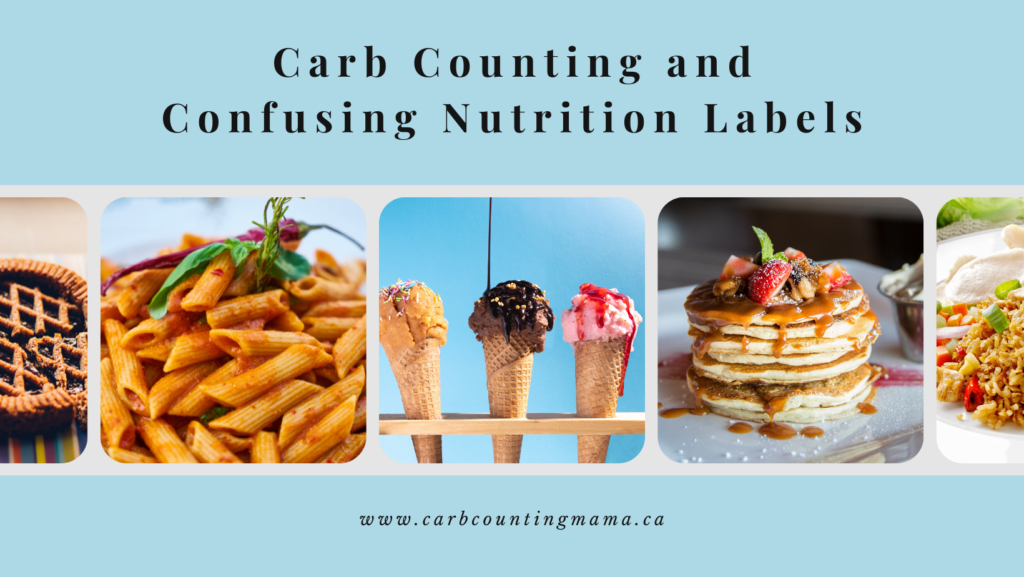
This post contains affiliate links
Nutrition labels are supposed to be a source of information. People on specific diets, people with allergies, and people with certain medical conditions often rely on the information that nutrition labels provide.
In many countries, legally, foods being sold have to have nutritional information readily available.
Unfortunately, particularly in North America, companies commonly create nutrition labels in a way that will make the product look better. Instead of being transparent about what is in the food, these labels are used as a marketing tool.
Two cookies have a really high calorie count? We’ll just change the portion size to one cookie. This individual bottle of juice has too many carbs? We’ll base the nutritional information on 2/3 of the bottle.
It makes the products look healthier than they are. Which is bad enough on its own. But what’s worse, it can make it really difficult for people who need to use that information.
Since people with T1D have to match their insulin to the carbs (and other macros) that they consume, getting correct carb counts from nutrition labels is very important.
Let’s talk about some confusing things you might come across when trying to use nutrition labels for carb counting.
Mistakes on nutrition labels
First, let’s acknowledge the fact that sometimes the information on the nutrition label is wrong.
It’s not uncommon for nutrition labels to have errors on them. And it’s really important to be able to recognize those mistakes so that you don’t make calculation errors.
There are a few dead giveaways that will tell you when there’s a typo on your label:
- The grams of carbs are higher than the weight. This is physically impossible. If it shows that the carbs are higher than the weight, don’t trust that label.
- The sub-categories below carbs add up to more than the total carbs. The sub-categories are there to tell you the breakdown of the total carbs. They let you know how much of the total is fiber, sugar, or sugar alcohols. Occasionally there will be other categories (including “other carbohydrates”). Under no circumstances will these subcategories add up to more than the amount shown in total carbohydrates.
- You’ve gotten fairly knowledgeable about what is in certain foods and the carb amount on the label just doesn’t seem right to you. Trust your gut, you’ll often be correct.
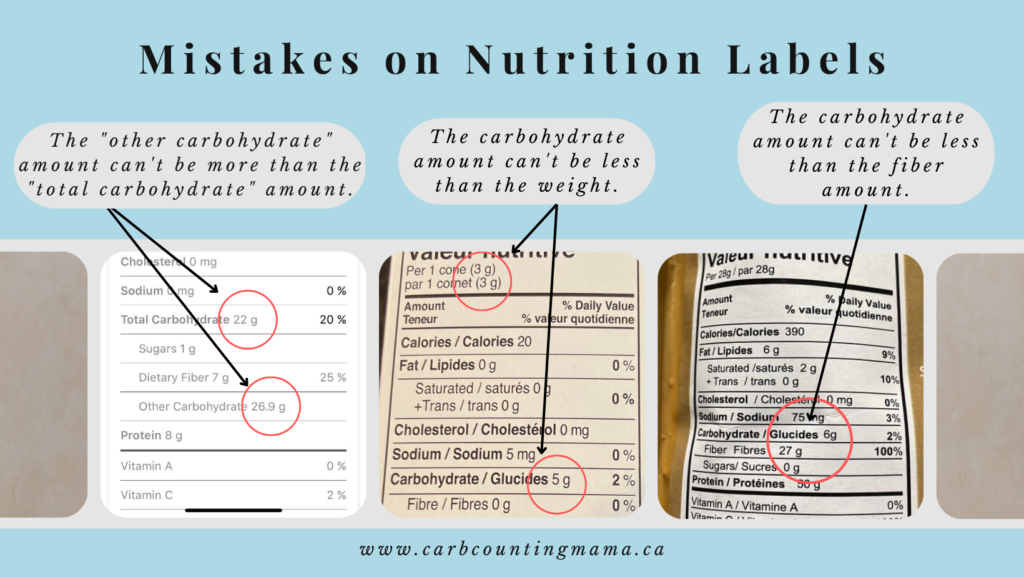
Here are a few examples.
The first label is for dried split green peas. The label claims there are 26.9 grams of “other carbohydrates” in a serving. However, there are only 22 grams of “total carbohydrates”. That’s simply not possible. Someone made an error with this label.
The second label is for an ice cream cone. If each cone weighs 3 grams, we can confidently say that there’s no way each cone has 5 grams of carbs in it.
The third label is for yeast. Again, fiber makes up part of the “total carbohydrate” or “carbohydrate” amount. It cannot be higher than what is listed for carbohydrates. This one is well over the limit!
If you see nutritional information like this on a label, that label might as well be garbage. Don’t use it to get carb counts.
What to do when you identify a typo in a nutrition label:
It’s a great idea to contact the company to notify them that there’s misinformation on their label. Take a picture, send it to the company, and explain to them the difference it could make to a person with T1D. Most people don’t know much about T1D, but if you explain that their label is used to calculate insulin, they might be inclined to follow up and fix the error.
But, you’re still sitting there with a useless label. How do you figure out the correct amount of carbs?
- If you’re confident enough, you can SWAG it. SWAG (Scientific Wild Ass Guess) is an educated estimate. If you aren’t used to SWAGing, this is probably not the best option. Even if you are confident with your SWAG abilities, there are more accurate ways to get the carb count.
- For some foods, you could use a carb factor. Simply multiply the weight by the carb factor to get the grams of carbs. Some foods will have easily accessible carb factors while others won’t.
- There’s an app for that. Apps like Calorie King and My Fitness Pal have carb calculators. You can try these apps, just be aware that if there’s a typo in the label on the package, these apps might be getting their information from that same label.
- Google. This is always my #1 choice if I need a carb count. It’s fast and easy. And you can get 3-4 answers all at once so that you can compare them. When the top 3 answers in Google are all different carb amounts, that’s when you know there’s a big problem.
Ridiculous portion sizes on nutrition labels
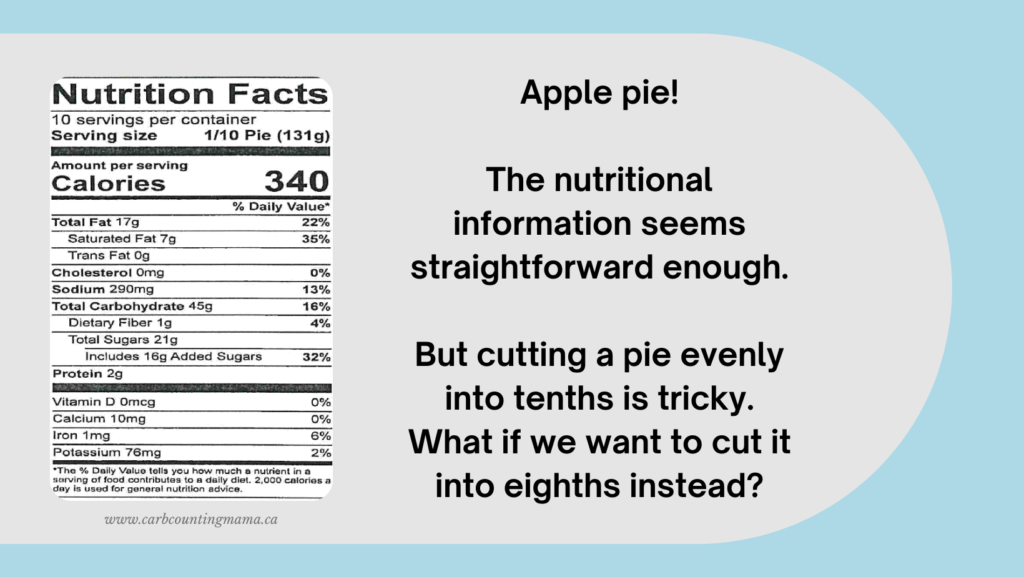
Have you ever gotten something and it’s an impossible portion size? Like, 1/5 of a pie. Who cuts pies into fifths? Maniacs, that’s who.
But that’s how it is sometimes listed on the label.
Even if it’s not something unreasonable like that, sometimes you want more or less than the portion size. How do we calculate that?
How to calculate the carbs when you’re eating an amount that is different from the portion size:
There are a couple of ways to do this. They involve a bit of calculating.
- With things like the pie label above, you can calculate the carb count for the entire pie and then divide it by the number of slices you’re cutting. 44 grams of net carbs for 1/10 of the pie means the entire pie has 440 grams of net carbs. So, if you’re cutting it into eighths, 440 ÷ 8 = 55 grams of net carbs per slice.
- Figure out the carb factor. You simply take the net carb amount and divide it by the weight. On the nutrition label for the pie above, that would be: 44 (net carbs) ÷ 131 (weight) = 0.33. Then you weigh the portion of food you want to eat and multiply it by the carb factor.
- Cross-multiplication will get you an accurate carb count. Let’s say you want to eat chips, but not the amount on the label. Weigh or count out the portion that you want to eat and cross multiply to get your carb count.
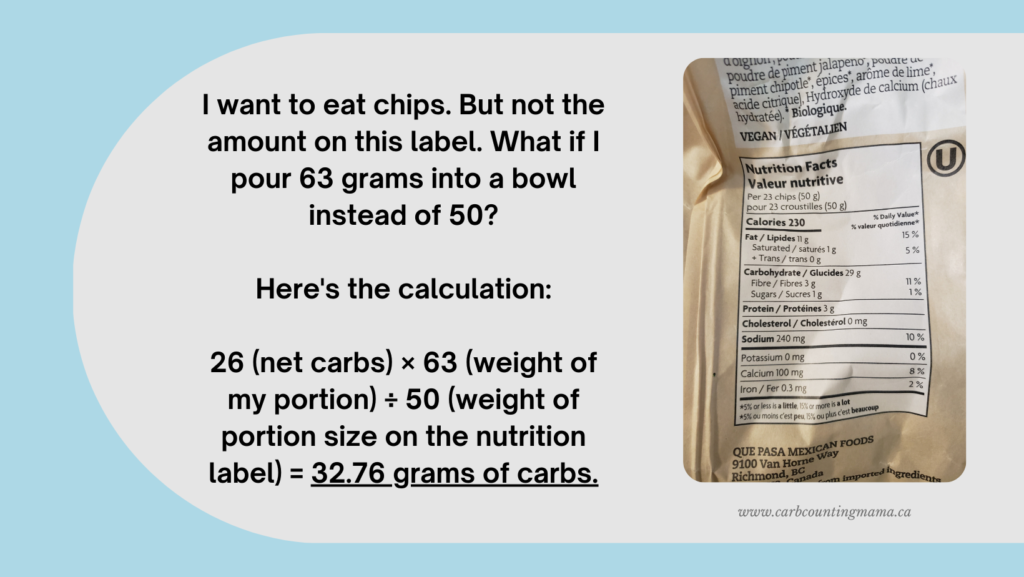
You can do this same calculation with the weight or the number of chips. Although, weight is always more accurate.
Whatever you’re eating, the calculation is: Net carbs of the portion size × the weight of the portion you’re going to eat ÷ the weight of the portion size on the nutrition label.
Now that we’ve got the basic calculations figured out, let’s talk about some particularly tricky foods and their confusing nutrition labels.
Wet or dry? Prepared or packaged?
Sometimes, the nutrition label tells you about the food in an inconvenient way. Yes, there’s nutritional information, but it’s not for the finished product.
Things like pasta, pancake mix, or rice need to be prepared, but the nutritional information provided is often for the dry version. That’s not very helpful for carb counting.
Pasta and rice
Before we even get to the nutrition label, pasta and rice are complicated to dose for.
First, the glycemic index changes if it’s freshly cooked vs leftovers that are being reheated.
Then, there’s the portion size. There are 3 main ways to measure portions of food:
- Counting. If you’re eating something like Oreos for instance, you can just count out how many you’re having. Somehow, I doubt anyone is interested in counting out spaghetti noodles or grains of rice.
- Volume. Lots of people use measuring cups for carb counting. These are best used for liquids. Solids are tricky because every time you measure, the amount will be slightly different. Pasta is particularly frustrating because it varies depending on the doneness of the pasta. Overcooked pasta will take up more volume than undercooked pasta. This is also true for rice.
- Weight. This is the best option for most foods. You simply use a nutrition scale and use the weight of the food to determine the carb count. To do this, you can use the codes from the nutrition scale, carb factors, or nutritional information from the package. But even with this method, it can be hard to get an accurate carb count. Overcooking, for instance, adds water weight, but doesn’t change the carb count.
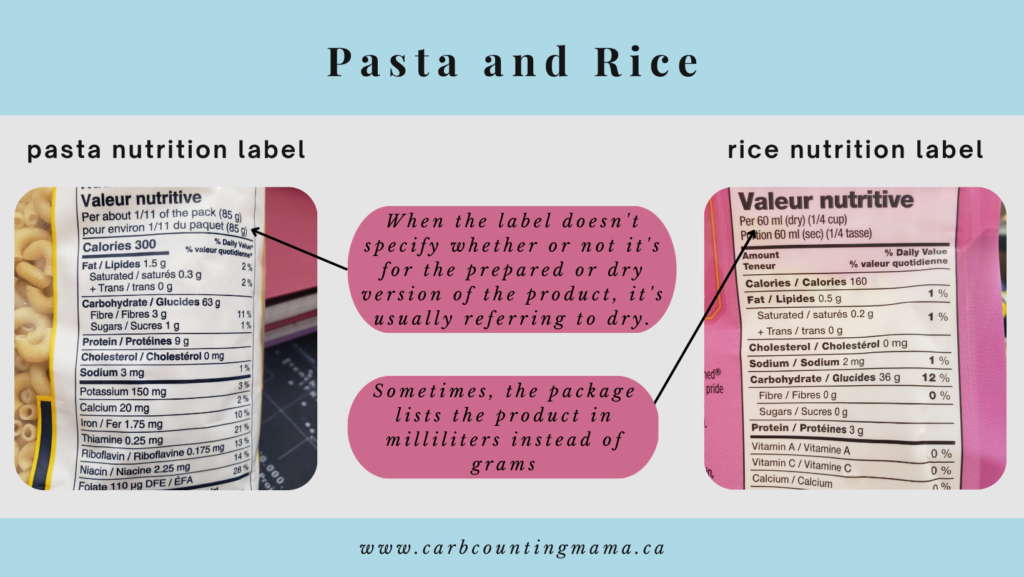
Figuring out carb counts for pasta and rice
Method 1:
The most accurate way to calculate the carb count for these foods is to measure, cook, and count the portion separately. This will take extra steps if you’re cooking for more than one person or if you find you want to eat more or less than what has been cooked.
Simply weigh the dry portion and get the carb count from that. Using the label above, if you weighed out 85 grams of dry pasta, you’d have 60 grams of net carbs. Or, the carb factor for the dry pasta would be 0.71 (60 ÷ 85). Using a carb factor allows you to measure out whatever portion you want rather than just using the amount on the package.
Method 2:
If you’re cooking for more than just yourself, and maybe you don’t have enough pots to separate the portions, method 1 might not be very practical.
When cooking multiple portions together, the most accurate way to calculate the carb count is to figure out the net carbs for the entire amount (like we did in method 1) and cook the pasta. When it’s drained, weigh the entire amount. The total carbs divided by the total weight is the carb factor for your cooked pasta. Then you can weigh individual portions and get the carb count from the carb factor.
Method 3:
That still sounds like a lot of effort, doesn’t it? If methods 1 and 2 don’t seem like your style, grabbing a carb factor online might be helpful. This won’t work well for kinds of pasta that are marketed as “high in protein”, “high in fiber”, “low net carbs”, and that sort of thing. All of those brands will have very different carb factors from your run-of-the-mill store-bought pasta brands.
The carb factor for cooked pasta is 0.29. Cooked brown rice is 0.21 and cooked white rice is 0.28. This is for the pasta or rice only. No butter, oils, or sauces included.
Simply weigh your portion of pasta or rice and multiply it by the appropriate carb factor.
Method 4:
If you don’t have a food scale, or the nutritional information is in milliliters instead of grams, using measuring cups will give you a good idea of how many grams of carbs you have. This is one of the least accurate ways to carb count for rice or pasta, but it still works.
Most online carb calculators and carb lists put a cup of cooked pasta around 40-45 grams of carbs. And, depending on the type, cooked rice has 42-48 grams of carbs per cup.
Cake, pancake, muffin, and cupcake mixes
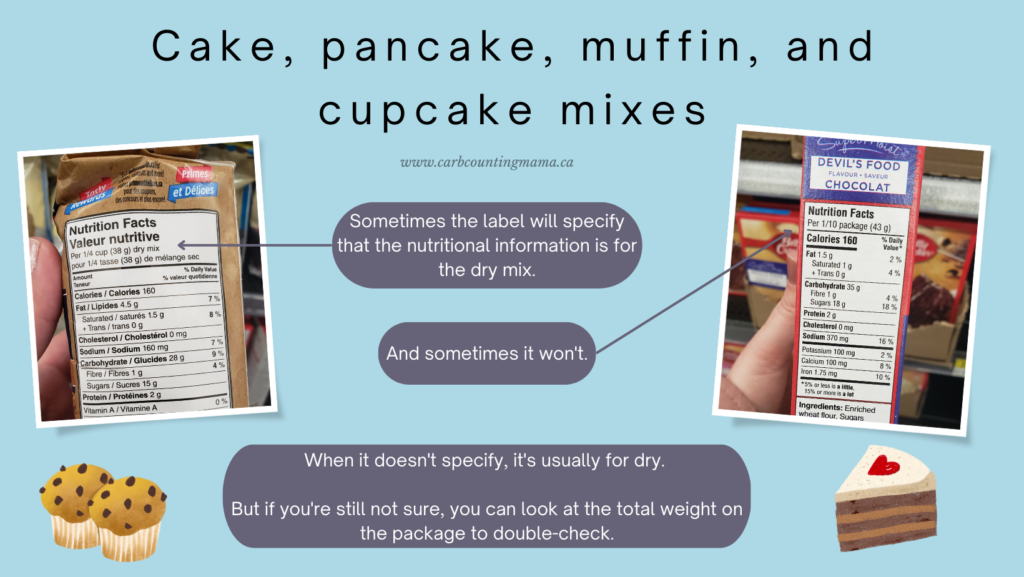
There are two main problems when it comes to carb counting these items.
First, like pasta and rice, the nutrition label is giving you information for the dry mix, not the prepared product that you’ll be eating.
Second, you often have to add other ingredients to these mixes, like milk, that will change the nutritional information.
So, how can we get an accurate carb count for these?
Honestly, it’s similar to how we figured it out for pasta and rice… except it’s easier and more accurate with these cake mixes!
Double checking the nutrition label
These labels are almost always for the dry mix. That said, it’s a good idea to double-check.
The package should list the total weight somewhere. And most of the nutritional labels that don’t specify whether it’s for dry or prepared use a fraction of the package (similar to the second image above).
If the nutritional information says it’s for 1/10 of the package, and the total weight of the portion is 43 grams, the entire package should weigh approximately 430 grams. If that math doesn’t work out, you’re either looking at the nutritional information for the finished product, or there’s a mistake on the label.
Calculating a carb count
You have the carb count for the dry mix that you’re using. Simply add any additional ingredients to get the carb count for the entire cake or batch.
That’s the carb count for the whole recipe. Now you can divide by the number of portions you have (individual muffins or cupcakes, or slices of cake) to get a carb count for an individual portion.
Or, you can weigh the finished product and divide the carb count by that weight. That will give you the carb factor. Carb factors for most baked goods are somewhere around 0.50, give or take.
Then you can use the carb factor to quickly calculate any portion of the finished product.
Solid foods that have milliliters on the nutrition label
I scream, you scream, we all scream…
Why must they put milliliters instead of grams on the nutrition labels for ice cream?!?
Yes, I suppose ice cream can melt into a liquid. But when portioning it out, squishing ice cream to perfectly fit into a measuring cup is not an easy task.
And that creates a big discrepancy in the carb count. So, what can we do to get a more accurate number?
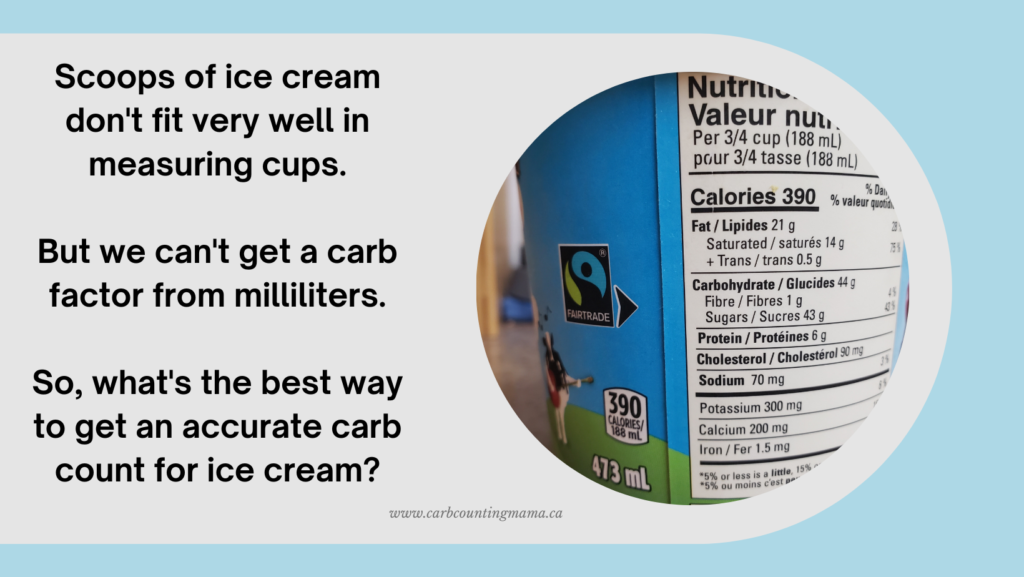
Don’t get me wrong, you can use measuring cups to get a ballpark carb count. It just won’t be super accurate most of the time. That’s one of the reasons people have a hard time dosing for ice cream.
It’s important to remember that milliliters don’t convert to grams. One is volume and the other is weight. This is also true of quarts, fluid ounces, and any other volume measurement. Keep in mind that a US fluid ounce is not the same amount as a British fluid ounce.
So, how can we get an accurate carb count?
Looking up carb factors won’t work very well with ice cream. Since there are so many different kinds, most carb factor lists just say something along the lines of “varies” for ice cream.
But, if the container of ice cream is not too large, you could calculate the carb factor yourself.
Notice on the label in the image above, the portion size is 188 ml and the carton contains 473 ml of ice cream. A quick calculation, 473 ÷ 188 x 43, tells us that there are approximately 108 grams of carbs in the entire container.
We can then weigh the full container, subtracting a few grams for the container itself, and figure out the carb factor.
That’s the most accurate way to get a carb count when the nutrition label is in milliliters.
The ice cream in the image has a carb factor of approximately 0.24.
Most people aren’t going to want to do all of those conversions. And sometimes it’s not an easy task to weigh the whole container. Using a measuring cup will work all right, but it’s not as accurate and you’ll likely need to make some adjustments afterward. Thank goodness for Sugar Surfing.
Nutrition labels on canned soup
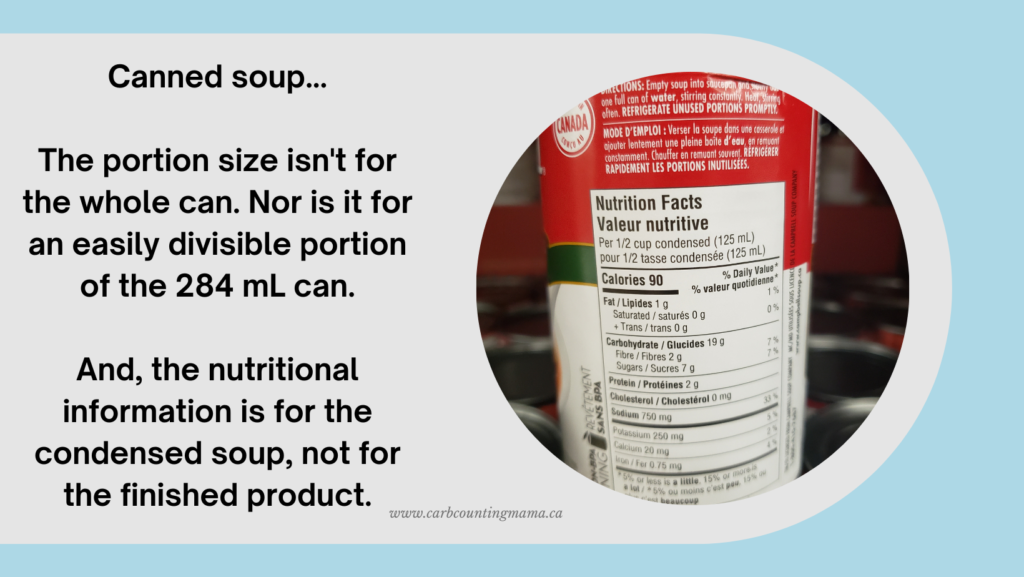
Canned soups have several hurdles.
We’ve talked about using milliliters (and other volume measurements). There’s no reason to convert canned soup into grams, using measuring cups is the best way to go.
We’ve also talked about how to do conversions. In this case, it’s usually best to calculate how many grams of carbs are in the entire can. In this case, 17 grams × 284 ml ÷ 125 ml = approximately 39 grams of carbs per can.
Many of these cans of soup require extra liquid. Some need a can of water while others call for a can of milk. Of course, if you’re adding milk, you’re adding carbs and have to account for that.
Either way, you’re diluting the original amount, so 1/2 a cup of the finished product won’t have 17 grams of net carbs like the label indicates. So that’s important to keep in mind when you’re portioning it out.
The big problem with these soups (and things like trail mix, chili, etc.) is they all have multiple ingredients so the carb count is an average. If you get more noodles, the carb count will be higher. With more broth, it’s going to be lower.
Nutrition labels can be confusing
As you can see, there are so many different methods of carb counting.
From carb factors to weighing, measuring, counting, or SWAGging… you’ll find the method(s) that work best for you.
Remember, it’s a good idea to use different methods depending on the food. Learning which methods work best with different foods will give you more accurate carb counts. And accurate carb counts mean more accurate insulin doses. Which means more time in range with fewer highs and lows.
It can be time-consuming and overwhelming to weigh and measure all of your food. But, just like everything else T1D, you do get better at it over time and it becomes second nature.
And that puts you one step closer to non-diabetic bg numbers.
Have you ever dealt with frustrating or confusing nutrition labels? Did the tips in this article help you figure out what to do?
For more tips and stories about T1D, join the Carb Counting Mama email list, and make sure to head over to the Carb Counting Mama Facebook page and “like” it.
Leave a Reply